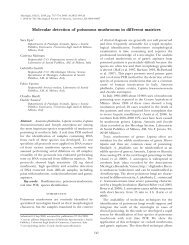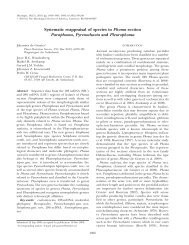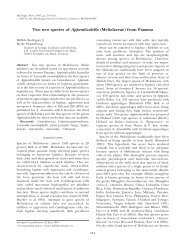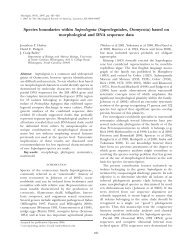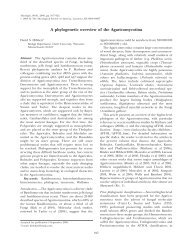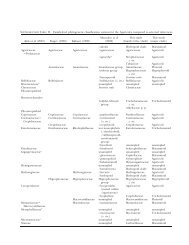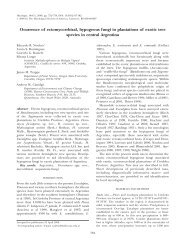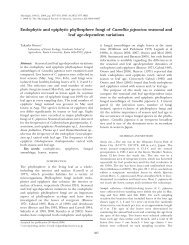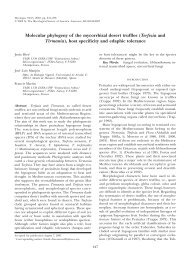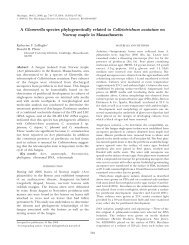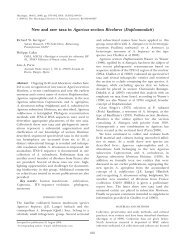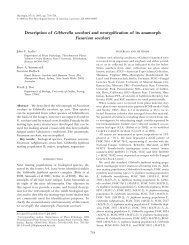Short title: Revision of Morchella taxonomy Taxonomic ... - Mycologia
Short title: Revision of Morchella taxonomy Taxonomic ... - Mycologia
Short title: Revision of Morchella taxonomy Taxonomic ... - Mycologia
Create successful ePaper yourself
Turn your PDF publications into a flip-book with our unique Google optimized e-Paper software.
in the fresh state. (See SUPPLEMENTARY MATERIALS for details on specific features.) For micromorphological study<br />
horizontal scalp sections taken from the hymenia and sterile ridges were squash-mounted in 2% KOH.<br />
Measurements <strong>of</strong> asci, paraphyses and elements on sterile ridges were made at 400× magnification; ascospore<br />
measurements were made at 1000×. At least 10 mature ascospores were measured for each specimen. Collections<br />
were deposited in the Mycology Collection <strong>of</strong> the Field Museum <strong>of</strong> Natural History in Chicago (F) using MDCP<br />
accession numbers or were studied and deposited in the Fungarium at the Royal Ontario Museum in Toronto<br />
(TRTC). Others were returned to lending herbaria. DNA sequence data from type specimens described in this study<br />
were deposited in GenBank under accession numbers JQ670119–JQ670132.<br />
RESULTS<br />
Study <strong>of</strong> 244 North American collections identified phylogenetically (see SUPPLEMENTARY<br />
TABLE I) revealed five species within the <strong>Morchella</strong> esculenta Clade as defined by O'Donnell et<br />
al. (2011) and nine species within the <strong>Morchella</strong> elata Clade (FIG. 1). Among these, a few<br />
phylogenetic species (<strong>Morchella</strong> rufobrunnea, M. tomentosa, M. importuna, M. prava, M.<br />
frustrata) could be differentiated on the basis <strong>of</strong> morphological characters, and several others (M.<br />
punctipes, M. populiphila, M. brunnea, M. capitata, M. snyderi) could be distinguished when<br />
geographic range and/or ecological factors are combined with morphological characters.<br />
However, several phylogenetic species (including the pair M. sextelata and M. septimelata and<br />
the pair M. esculentoides and M. cryptica) remain morphologically and ecologically cryptic<br />
based on present data. Type studies (see SUPPLEMENTARY MATERIALS) supported applying four<br />
<strong>of</strong> the six previous North American species names (M. angusticeps, M. punctipes, M.<br />
rufobrunnea, M. tomentosa) to phylogenetic species. However, two previous North American<br />
names were problematic: (i) the type collection <strong>of</strong> M. crassistipa was determined to be mixed,<br />
obliging us to designate this name as nomen dubium; and (ii) preliminary DNA sequence data on<br />
M. hotsonii suggested that it might represent a novel phylogenetic species, apparently<br />
undocumented since the 1935 type collection. As a result <strong>of</strong> our analyses 14 new species are



